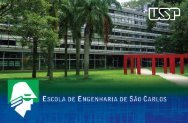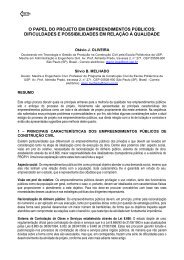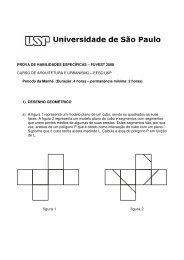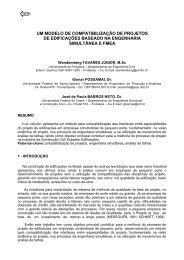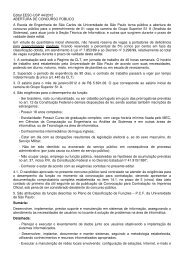Anais do I Seminário do Projeto Temático - Escola de Engenharia ...
Anais do I Seminário do Projeto Temático - Escola de Engenharia ...
Anais do I Seminário do Projeto Temático - Escola de Engenharia ...
Create successful ePaper yourself
Turn your PDF publications into a flip-book with our unique Google optimized e-Paper software.
60<br />
<strong>de</strong> reagente, como foi <strong>de</strong>monstra<strong>do</strong> em trabalhos anteriores (Belli<strong>do</strong> e Assaf (2009), Belli<strong>do</strong> et<br />
al(2009) e Asencios et al (2011).<br />
A solução sólida Y 2 O 3 -ZrO 2 forma vacâncias <strong>de</strong> oxigênio, e como foi reporta<strong>do</strong> na<br />
literatura (Belli<strong>do</strong> e Assaf (2009), Belli<strong>do</strong> et al(2009)) o catalisa<strong>do</strong>r Ni/Y 2 O 3 -ZrO 2 (Ni<br />
=5%wt, Y 2 O 3 =8mol%) é ativo na RSM, mas produz uma consi<strong>de</strong>rável quantida<strong>de</strong> <strong>de</strong> coque e<br />
valores da razão H 2 /CO relativamente baixos. O presente projeto propõe preparar<br />
catalisa<strong>do</strong>res NiO/ZrO 2 /Y 2 O 3 pelo méto<strong>do</strong> <strong>de</strong> polimerização numa única etapa, com cargas<br />
superiores <strong>de</strong> Y 2 O 3 e <strong>de</strong> Ni, e estudar seu <strong>de</strong>sempenho na reforma <strong>de</strong> um biogás i<strong>de</strong>al com<br />
adição <strong>de</strong> oxigênio, visto que este processo envolve duas reações combinadas: RSM e OPM.<br />
Material e Méto<strong>do</strong>s<br />
Os catalisa<strong>do</strong>res serão prepara<strong>do</strong>s pelo méto<strong>do</strong> <strong>de</strong> polimerização numa única etapa. A<br />
meto<strong>do</strong>logia se encontra <strong>de</strong>talhada em Asencios et al(2011). Assim, serão mistura<strong>do</strong>s os três<br />
sais, Ni(NO 3 ) 2 .6H 2 O; Zr(CO 3 ) 2 .1,5H 2 O e Y(NO 3 ) 3 .6H 2 O. O conteú<strong>do</strong> em mols <strong>de</strong> Y 2 O 3 em<br />
relação ao ZrO 2 será 0%, 4%, 20% e 40% e a carga <strong>do</strong> níquel será mantida constante em 20%<br />
massa. Os polímeros obti<strong>do</strong>s serão calcina<strong>do</strong>s a 500°C (10ºC.min -1 ) por 3h e, após, a 750ºC<br />
(10ºC.min -1 ) por 2h sob fluxo <strong>de</strong> ar sintético.<br />
Os sóli<strong>do</strong>s serão caracteriza<strong>do</strong>s por difração <strong>de</strong> raios X (DRX), adsorção-<strong>de</strong>ssorção <strong>de</strong><br />
N 2 (BET) e redução a temperatura programada com H 2 (TPR).<br />
Os testes catalíticos serão realiza<strong>do</strong>s em um reator tubular <strong>de</strong> quartzo (d.i.=10mm)<br />
com 100mg <strong>de</strong> catalisa<strong>do</strong>r a 750ºC e uma mistura gasosa com razão <strong>de</strong> CH 4 /CO 2 /O 2<br />
1,5:1:0,25, para simular a condição <strong>de</strong> um biogás i<strong>de</strong>al (CH 4 :CO 2 1.5:1) mais a adição <strong>do</strong><br />
oxigênio. O fluxo total <strong>do</strong>s gases será 107,5mL.h -1 , o oxigênio será adiciona<strong>do</strong> em forma <strong>de</strong> ar<br />
sintético. O tempo <strong>de</strong> reação será <strong>de</strong> 7h. Antes <strong>do</strong> início das reações, os catalisa<strong>do</strong>res serão<br />
reduzi<strong>do</strong>s a 800ºC por 1h, sob fluxo <strong>de</strong> H 2 (30 mL.h -1 ). Os produtos e reagentes não<br />
converti<strong>do</strong>s serão analisa<strong>do</strong>s em um cromatógrafo a gás (Varian, Mo<strong>de</strong>lo 3800), em linha com<br />
a unida<strong>de</strong> <strong>de</strong> teste catalítico. O cromatógrafo contém <strong>do</strong>is <strong>de</strong>tectores <strong>de</strong> condutivida<strong>de</strong> térmica<br />
e colunas empacotadas <strong>do</strong> tipo peneira molecular 13X e Porapak N, a primeira utiliza N 2<br />
como gás <strong>de</strong> arraste para análise <strong>do</strong> H 2 e a outra utiliza He como gás <strong>de</strong> arraste para a análise<br />
<strong>de</strong> CO 2 , CH 4 e CO.<br />
Referências Bibliográficas<br />
Asencios, Y. J.; Belli<strong>do</strong>, J. D. A.; Assaf, E. M. (2011) Synthesis of NiO–MgO–ZrO 2 catalysts<br />
and their performance in reforming of mo<strong>de</strong>l biogas. Appl. Catal. A. 397, 138-144.<br />
Ashcroft, A. ; Cheetham, A.; Foord, J.; Green, M.; Grey, C.; A. Murrell; P. Vernon. (1990)<br />
Selective oxidation of methane to synthesis gas using transition metal catalysts. Nature,<br />
344, 319-321.<br />
Ashcroft, A.; Cheetham, A.; Green, M.; Vernon P. (1991) Partial oxidation of methane to<br />
synthesis gas using carbon dioxi<strong>de</strong>. Nature, 352, 225-228.<br />
Belli<strong>do</strong>, J. D. A.; Tanabe, E. Y.; Assaf, E. M. (2009) Carbon dioxi<strong>de</strong> reforming of ethanol<br />
over Ni/Y 2 O 3 –ZrO 2 catalysts. Applied Catalysis B, 90, 485–488.<br />
Belli<strong>do</strong>, J. D. A.; Assaf, E. M. (2009) Effect of the Y 2 O 3 –ZrO 2 support composition on<br />
nickel catalyst evaluated in dry reforming of methane. Appl. Catal. A, 352, 352, 179–187.<br />
Hegarty, M.E.S.; O’Connor, A.M.; Ross, J.R.H. (1998) Syngas production from natural gás<br />
using ZrO 2 -supported metals. Catalysis Today, 42, 225-232.<br />
Ruckenstein, E.; Hang, Y. (1998) Combination of CO 2 reforming and partial oxidation of<br />
methane over the NiO/MgO solid solution catalyst. Ind. Eng. Chem. Res., 37, 1744-1747.<br />
Supaporn, T.; Chairut, S.; Apichai, T. (2008). Improvement of coke resistance of Ni/Al 2 O 3<br />
catalyst in CH 4 /CO 2 reforming by ZrO 2 addition. Fuel Process. Technol. 89, 160-168.


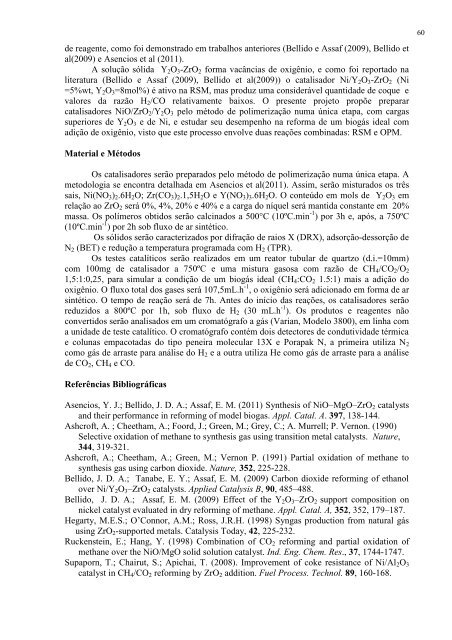
![monografia [arquivo *.pdf 737 Kb] - USP](https://img.yumpu.com/26135843/1/184x260/monografia-arquivo-pdf-737-kb-usp.jpg?quality=85)
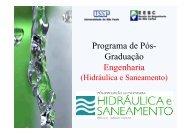
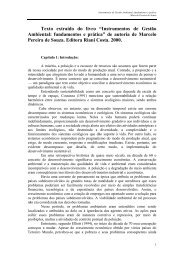
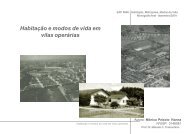
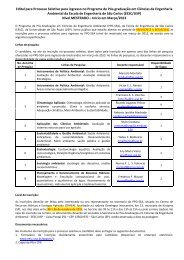
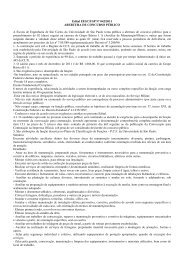


![monografia [arquivo *.pdf 8,2 Mb] - Escola de Engenharia de São ...](https://img.yumpu.com/26135810/1/184x260/monografia-arquivo-pdf-82-mb-escola-de-engenharia-de-sao-.jpg?quality=85)
